
Cast * Story * Interesting Facts * Dean DeBlois Interview * Chris Sanders Interview * Clark Spencer Interview * Tia Carrere Interview

Cast * Story * Interesting Facts * Dean DeBlois Interview * Chris Sanders Interview * Clark Spencer Interview * Tia Carrere Interview
Directed by: Chris Sanders and Dean Deblois
Written by: Chris Sanders
Music by: Alan Silvestri (score), Elvis Presley (songs)
Production Started Date: August 5, 1999
Production End Date: pushed back from May 2001 to late Summer/Fall
2001 due to budget cuts
Release Date: June 21, 2002
Running Time: 80 minutes
Budget: $80 million plus $40 million in marketing costs
U.S. Opening Weekend: $35.8 million over 3,191 screens
Box Office: $145.66 million in the U.S., $257.4 million worldwide
Video Revenue: $207.6 million from DVD and VHS rentals and sales
 |
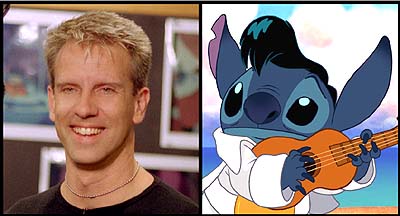 |
 |
 |
Lilo... Daveigh Chase
Stitch... Chris Sanders
David Kawena... Jason Scott Lee
Nani (Lilo's sister)... Tia Carrere
Mell/Maid in Lilo's home... Laurie Metcalf
Jumba (a bounty hunter)... David Ogden Stiers
Pleakley... Kevin McDonald
Cobra Bubbles... Ving Rhames
Grand Councilwomen... Zoe Caldwell
Captain Gantu... Kevin Richardson
Alien Judge... Judi Dench (not officially confirmed)
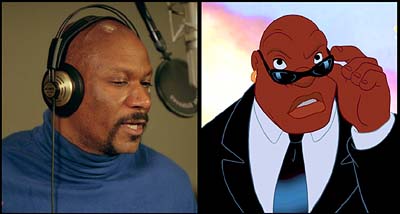 |
 |
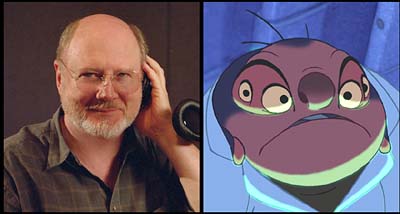 |
 |
Lilo is a sweet little Hawaiian girl who's a quite peculiar: she has an off-beat take on life, and is a little obsessed about taking care of downtrodden animals. Each day, she collects all the soda cans along the beach in Waikiki. She then takes the cans to the local recycling center, turns them in for cash, then uses that money to buy fish food -she gets in an outrigger canoe, paddles out into the middle of the harbor, then begins feeding the fish in the ocean.
Meanwhile, on the other side of the galaxy, we meet career criminal Stitch. An incorrigible unrepentant felon, this six-armed alien stands before the galactic tribunal. Just as the judge is about to pronounce sentence, Stitch escapes.
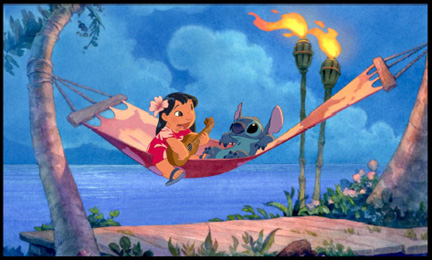 Zooming
through the stars in his cool 1950s-style spaceship (complete with fins),
Stitch tries to elude the two bounty hunters who've been sent out to recapture
him. (Again, my apologies, but I don't have the names of these two characters
handy. I have heard that Disney wanted David Ogden Stiers to voice one
bounty hunter and Mark McKinney from The Kids in the Hall to provide vocals
for the other.) Hoping to ditch the cops, the six-armed con crash-lands
on Earth.
Zooming
through the stars in his cool 1950s-style spaceship (complete with fins),
Stitch tries to elude the two bounty hunters who've been sent out to recapture
him. (Again, my apologies, but I don't have the names of these two characters
handy. I have heard that Disney wanted David Ogden Stiers to voice one
bounty hunter and Mark McKinney from The Kids in the Hall to provide vocals
for the other.) Hoping to ditch the cops, the six-armed con crash-lands
on Earth.
Where on Earth? Hawaii. To be specific, near the beach on Waikiki.
Stitch's only hope for eluding capture is to blend in with the locals. However -due to his bug eyes and blue fur- there's no way that he'll pass for human. But then Stitch notices that -if he folds up one set of arms under his fur- he can sort of pass for a dog. A really ugly, weird looking dog with blue fur.
At least, that's what the Animal Control Officer thinks when he captures Stitch. So there he is -back behind bars, just days away from being put to sleep- when Lilo comes into the pound and decides to adopt the crazy looking canine.
Stitch initially is looking to escape as soon as Lilo springs him from the pound. But the little girl keeps the still-disguised-as-a-dog extraterrestrial on a pretty short leash.
Lilo, her older sister Nani, and a handsome surfboard salesman -who
is attracted to Nani but he is intimidated by the fact that she is sightly
taller than he is- all get caught up in a crazy adventure as the two alien
bounty hunters land on Earth to retrieve Stitch. Would you be surprised
to learn that through her innocent and trusting and idiosyncratic treatment
of him, Stitch develops a heart?...
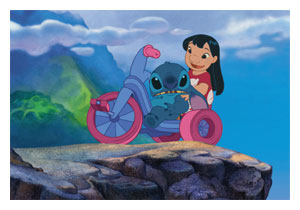 |
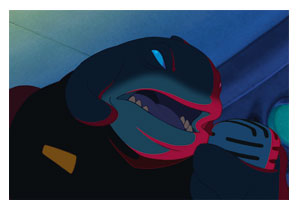 |
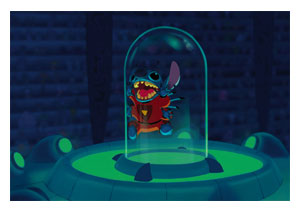 |
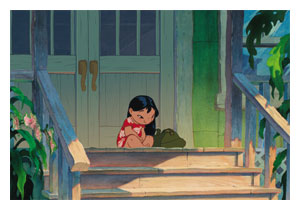 |
![]() Some production
was done in Honolulu, Hawaii, but Lilo and Stitch was shot mainly
at the Orlando Studios. Therefore, drawings could be seen very early
on at Disneyworld's animation studio, through MGM Studios' guided tour.
A visitor revealed on September 20, 2000 that they include room furniture
(coffee pots, bags), Tiki torches, and two sections labeled "David's surfboard"
and "Guargu's (space) Ship".
Some production
was done in Honolulu, Hawaii, but Lilo and Stitch was shot mainly
at the Orlando Studios. Therefore, drawings could be seen very early
on at Disneyworld's animation studio, through MGM Studios' guided tour.
A visitor revealed on September 20, 2000 that they include room furniture
(coffee pots, bags), Tiki torches, and two sections labeled "David's surfboard"
and "Guargu's (space) Ship".
![]() The story
was cooked up by one of Disney's top story guys, Chris Sanders (The
Lion King, Mulan), who created
an illustrated story outline that everyone fell in love with. He first
began thinking about a Stitch-like character nearly 17 years ago when he
was just out of school.
The story
was cooked up by one of Disney's top story guys, Chris Sanders (The
Lion King, Mulan), who created
an illustrated story outline that everyone fell in love with. He first
began thinking about a Stitch-like character nearly 17 years ago when he
was just out of school.
![]() In the
early stages of story development, Stitch landed in rural Kansas and interacted
entirely with animals. Animation president Thomas Schumacher suggested
that Stitch interact with people instead, while a well-timed Hawaii vacation
gave Sanders the idea to move the story from the barnyard to the beach.
In the
early stages of story development, Stitch landed in rural Kansas and interacted
entirely with animals. Animation president Thomas Schumacher suggested
that Stitch interact with people instead, while a well-timed Hawaii vacation
gave Sanders the idea to move the story from the barnyard to the beach.
![]() Rodger
Allers (who wrote the stories of Oliver
& Company, The Little Mermaid,
Beauty
and the Beast and Aladdin, then
directed The Lion King, before leaving
the troubled The Emperor's New Groove
for this project) was originally set to direct Lilo and Stitch.
Chris Sanders, who created the original story, took over to helm the project
along newcomer Dean Deblois (layout artist for 1990's The Nutcracker
Prince starring Peter O'Toole).
Rodger
Allers (who wrote the stories of Oliver
& Company, The Little Mermaid,
Beauty
and the Beast and Aladdin, then
directed The Lion King, before leaving
the troubled The Emperor's New Groove
for this project) was originally set to direct Lilo and Stitch.
Chris Sanders, who created the original story, took over to helm the project
along newcomer Dean Deblois (layout artist for 1990's The Nutcracker
Prince starring Peter O'Toole).
![]() The filmmakers
and artistic supervisors spent two weeks in Hawaii, mostly on the island
of Kauai, studying scenery and local customs prior to making the film.
But the most important element they took away with them, they say, was
the concept of “ohana”--that is, the sense of family or unity Hawaiians
share.
The filmmakers
and artistic supervisors spent two weeks in Hawaii, mostly on the island
of Kauai, studying scenery and local customs prior to making the film.
But the most important element they took away with them, they say, was
the concept of “ohana”--that is, the sense of family or unity Hawaiians
share.
![]() Co-director
Chris Sanders provides Stitch's voice, a sort of E.T. croak that he uses
to annoy his fellow animators. Lilo partner Dean DeBlois' Boston terrier,
Theodore, provided his slurps and snorts after snacking on peanut butter.
Co-director
Chris Sanders provides Stitch's voice, a sort of E.T. croak that he uses
to annoy his fellow animators. Lilo partner Dean DeBlois' Boston terrier,
Theodore, provided his slurps and snorts after snacking on peanut butter.
![]() Look for
Dumbo, star of the last Disney full-length animated movie before Lilo
to feature only watercolor backgrounds (in 1941).
Look for
Dumbo, star of the last Disney full-length animated movie before Lilo
to feature only watercolor backgrounds (in 1941).
![]() Lilo was
influenced by Japanese anime master Hayao Miyazaki (My
Neighbor Totoro, Kiki's
Delivery Service). Says DeBlois, "He creates genuine relationships
in the realm of fantasy." Kiki's Coffee House is a tribute.
Lilo was
influenced by Japanese anime master Hayao Miyazaki (My
Neighbor Totoro, Kiki's
Delivery Service). Says DeBlois, "He creates genuine relationships
in the realm of fantasy." Kiki's Coffee House is a tribute.
![]() The Mulan
Wok eatery is a nod to the Disney film that Sanders
and Dean DeBlois worked on previously.
The Mulan
Wok eatery is a nod to the Disney film that Sanders
and Dean DeBlois worked on previously.
![]() The movie
that Stitch watches on the television in the store window is 1958's Earth
vs. the Spider.
The movie
that Stitch watches on the television in the store window is 1958's Earth
vs. the Spider.
![]() Andreas
Deja (the animator of Gaston,
Triton,
Hercules,
Scar
and Jafar amongst other Disney characters) revealed
early on that the film was going to be in a cartoony style, similar to
the animation style of an old Disney animator named Freddie Moore.
Andreas called it the best story he's seen since he's been at Disney!
Andreas
Deja (the animator of Gaston,
Triton,
Hercules,
Scar
and Jafar amongst other Disney characters) revealed
early on that the film was going to be in a cartoony style, similar to
the animation style of an old Disney animator named Freddie Moore.
Andreas called it the best story he's seen since he's been at Disney!
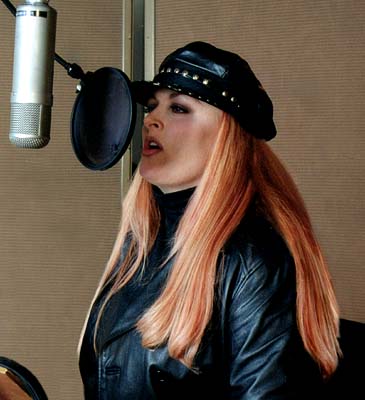
![]() Lilo
and Stitch is not a musical, though Disney has bought the rights to
six Elvis songs, because Lilo likes to hula dance on the beach to Elvis
music: "Hound Dog", "Devil in Disguise", "Burning Love", "I'm Coming Home",
"Stuck on You" and "Heartbreak Hotel". A traditional Hawaiian song that
was written by Queen Liliuokalani, the last Hawaiian monarch, and entitled
"Aloha O'e", will be performed by Tia Carrere. Alan
Silvestri completed the recording of the score in late November 2001.
Lilo
and Stitch is not a musical, though Disney has bought the rights to
six Elvis songs, because Lilo likes to hula dance on the beach to Elvis
music: "Hound Dog", "Devil in Disguise", "Burning Love", "I'm Coming Home",
"Stuck on You" and "Heartbreak Hotel". A traditional Hawaiian song that
was written by Queen Liliuokalani, the last Hawaiian monarch, and entitled
"Aloha O'e", will be performed by Tia Carrere. Alan
Silvestri completed the recording of the score in late November 2001.
![]() Disney
has supposedly VERY high hopes for this movie. It has been the praise
of Disney animators for a while, and they're saying this is the film that's
going to bring back the animated feature in a BIG way.
Disney
has supposedly VERY high hopes for this movie. It has been the praise
of Disney animators for a while, and they're saying this is the film that's
going to bring back the animated feature in a BIG way.
![]() Art
from Lilo and Stitch was unveiled in the Disney Animation building
of the new Disney's California Adventure in January 2001. Stitch
is said to look like a cute baby panda bear with fangs. One scene
displayed shows a female alien with tentacles for hair and an alien with
one eye and a gumdrop-shaped head talking about how to get Stitch back.
They apparently are police agents. Someone asks why they can't blow up
the Earth and the gumdrop alien replies that they can't because it is a
nature preserve for the endangered mosquito (they are breeding them here).
The scene continues with the two discussing who to send to get Stitch back
before they decide on this big looking alien who we see in shadow behind
bars.
Art
from Lilo and Stitch was unveiled in the Disney Animation building
of the new Disney's California Adventure in January 2001. Stitch
is said to look like a cute baby panda bear with fangs. One scene
displayed shows a female alien with tentacles for hair and an alien with
one eye and a gumdrop-shaped head talking about how to get Stitch back.
They apparently are police agents. Someone asks why they can't blow up
the Earth and the gumdrop alien replies that they can't because it is a
nature preserve for the endangered mosquito (they are breeding them here).
The scene continues with the two discussing who to send to get Stitch back
before they decide on this big looking alien who we see in shadow behind
bars.
![]() Animators
have devised a new type of walk cycle for the alien ambassador who hires
the alien bounty hunters because he has three legs.
Animators
have devised a new type of walk cycle for the alien ambassador who hires
the alien bounty hunters because he has three legs.
![]() Stitch
doesn't speak for most of the movie -the film is not told through snappy
dialogue but rather through cleverly staged visual set pieces.
Stitch
doesn't speak for most of the movie -the film is not told through snappy
dialogue but rather through cleverly staged visual set pieces.
![]() Production
on this project was supposed to wrap in May 2001, but due to budget cuts
was reportedly only completed in late summer/fall 2001.
Production
on this project was supposed to wrap in May 2001, but due to budget cuts
was reportedly only completed in late summer/fall 2001.
![]() Lilo
& Stitch is the first animated feature in years from Walt Disney
Studios that's based on an original story. The tale was crafted by noted
storyboard artist Chris Sanders. He's the genius who came up with the staging
for many of your favorite moments in Beauty
and the Beast, Aladdin, and The
Lion King. Chris made his directorial debut with Lilo
& Stitch.
Lilo
& Stitch is the first animated feature in years from Walt Disney
Studios that's based on an original story. The tale was crafted by noted
storyboard artist Chris Sanders. He's the genius who came up with the staging
for many of your favorite moments in Beauty
and the Beast, Aladdin, and The
Lion King. Chris made his directorial debut with Lilo
& Stitch.
![]() Animator
Andreas Deja recalled in a March 2003 interview that "I was actually on
The
Emperor’s New Groove. It started out being called Kingdom of the
Sun. We had done a little work, and they realized that the story needed
to be plussed, so it kind of started over again. During that time, I was
on the floor where they have the development work for the features, and
I saw these drawings that Chris Sanders had done of a little Hawaiian girl.
She was holding a fish, and it immediately looked extremely appealing to
me--the style and the situations. They found out that I was interested
in the project so they said, 'Let’s pitch you the whole story.' So a week
later they pitched me the outline and I just loved it because it was so
different, so unusual and quirky, yet there was personality and heart.
I thought that I really wanted to work on this. I was the first animator
that jumped productions, because Kingdom was starting over and becoming
Emperor’s
New Groove. I switched over to Lilo & Stitch and I did
pretty much development work on all the characters, because Chris and Dean
the directors wanted to see which character I would feel the closest to.
After seeing sketches of Nani and Stitch and the social worker and David
and all of them, they said, 'You know, there’s something in these Lilo
drawings that you connect with that character.' So I was very happy to
take over that assignment. Lilo became a really fun character--she is so
unusual and yet real, in many ways like a real kid. I really had a chance
to crawl into that little character and animate her from the inside-out--that’s
what I tried anyway, to really feel her pain and her loneliness and all
of that."
Animator
Andreas Deja recalled in a March 2003 interview that "I was actually on
The
Emperor’s New Groove. It started out being called Kingdom of the
Sun. We had done a little work, and they realized that the story needed
to be plussed, so it kind of started over again. During that time, I was
on the floor where they have the development work for the features, and
I saw these drawings that Chris Sanders had done of a little Hawaiian girl.
She was holding a fish, and it immediately looked extremely appealing to
me--the style and the situations. They found out that I was interested
in the project so they said, 'Let’s pitch you the whole story.' So a week
later they pitched me the outline and I just loved it because it was so
different, so unusual and quirky, yet there was personality and heart.
I thought that I really wanted to work on this. I was the first animator
that jumped productions, because Kingdom was starting over and becoming
Emperor’s
New Groove. I switched over to Lilo & Stitch and I did
pretty much development work on all the characters, because Chris and Dean
the directors wanted to see which character I would feel the closest to.
After seeing sketches of Nani and Stitch and the social worker and David
and all of them, they said, 'You know, there’s something in these Lilo
drawings that you connect with that character.' So I was very happy to
take over that assignment. Lilo became a really fun character--she is so
unusual and yet real, in many ways like a real kid. I really had a chance
to crawl into that little character and animate her from the inside-out--that’s
what I tried anyway, to really feel her pain and her loneliness and all
of that."
![]() The workspace
of animators working on this project in Orlando has been decorated in an
island motif for inspiration. A big "Aloha" banner was placed at
the entrance of the animation area, with tropical themed party decorations
like paper pineapples and leis in every cubicle. Some genuine Hawaiian
artifacts like tiki totems and lamps were also scattered around the place.
The workspace
of animators working on this project in Orlando has been decorated in an
island motif for inspiration. A big "Aloha" banner was placed at
the entrance of the animation area, with tropical themed party decorations
like paper pineapples and leis in every cubicle. Some genuine Hawaiian
artifacts like tiki totems and lamps were also scattered around the place.
![]() On Daveigh
Chase, Dean DeBlois said that "we probably listened to about 150 girls
and we were looking for someone who got the comedy of Lilo, but more importantly,
got the dark side of Lilo. We had written some pages specifically to bring
out that side of Lilo because she is very isolated in her own world, emotionally
and externally. Daveigh came in on her first try, without any coaching
from us, and nailed it on her first audition. We just didn't have to tell
her anything, but she knew from the character description she had read
and she had a specific voice in her mind of the way she wanted to read
it and it was exactly what we were looking to hear. She has this great
sort-of haunting quality to her."
On Daveigh
Chase, Dean DeBlois said that "we probably listened to about 150 girls
and we were looking for someone who got the comedy of Lilo, but more importantly,
got the dark side of Lilo. We had written some pages specifically to bring
out that side of Lilo because she is very isolated in her own world, emotionally
and externally. Daveigh came in on her first try, without any coaching
from us, and nailed it on her first audition. We just didn't have to tell
her anything, but she knew from the character description she had read
and she had a specific voice in her mind of the way she wanted to read
it and it was exactly what we were looking to hear. She has this great
sort-of haunting quality to her."
![]() Producer
Clark Spencer commented on the casting of Tia Carrera & Jason Scott
Lee saying that "we wanted to get some Hawaiian voices in the film because
(the film) takes place in Hawaii. So Tia Carrera and Jason Scott Lee were
two people we went after.They both brought a Hawaiian element and a local
flavor to the film. Often times, when we got together to record, we'd ask
them how would you say this in if you lived in Hawaii, and it would change.
Plus, they both have really wonderful voices. It kind of surprised us with
Tia because we didn't know she grew up in Hawaii and the only audio we
had of her was her performance from Wayne's World and Eraser. In both cases,
she played tough characters or screechy character and she didn't embody
the warmth we wanted for the character, until she came in for the audition.
And then she saw the material and started reading it with this warmth and
sincerity that got us all excited about having found her."
Producer
Clark Spencer commented on the casting of Tia Carrera & Jason Scott
Lee saying that "we wanted to get some Hawaiian voices in the film because
(the film) takes place in Hawaii. So Tia Carrera and Jason Scott Lee were
two people we went after.They both brought a Hawaiian element and a local
flavor to the film. Often times, when we got together to record, we'd ask
them how would you say this in if you lived in Hawaii, and it would change.
Plus, they both have really wonderful voices. It kind of surprised us with
Tia because we didn't know she grew up in Hawaii and the only audio we
had of her was her performance from Wayne's World and Eraser. In both cases,
she played tough characters or screechy character and she didn't embody
the warmth we wanted for the character, until she came in for the audition.
And then she saw the material and started reading it with this warmth and
sincerity that got us all excited about having found her."
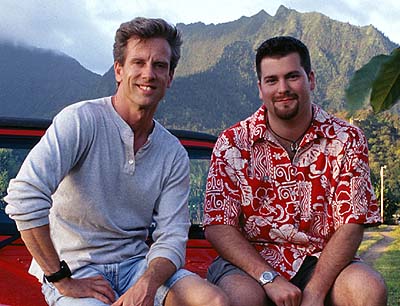
![]() Disney
switched from Kansas to Kaua'i for the setting of its upcoming movie thanks,
in large part, to a Garden Island tour guide and the 'ohana spirit of the
Islands that he emphasized while the writer-directors were visiting several
years ago. "Chris [Sanders, 40] had a map (of Hawai'i) on the wall when
we were still working on the story," said Dean DeBlois, 31. "Chris kept
thinking that these small towns on Kaua'i he visited; they were perfect
in size, with obvious beauty—and had the spirit of 'ohana." Clark
Spencer, 39, who is making his debut as producer with Lilo, adds that "'ohana
was not part of the original script. On a research trip (in Hawai'i), everybody
spoke of 'ohana. For Stitch and his transformation, what would be better
than 'ohana? He comes to know what it means to have family. It struck a
chord and really resonates in a wonderful way. It will be great for cultures
outside of the USA who might not have heard about it." Sanders is forever
grateful to a tour guide he refers to only as Francis, "who knew everybody
everywhere we went on Kaua'i, which made me realize what a tight-knit community
Hawai'i was. The idea was that there were broader implications of 'ohana;
that Stitch, the ultimate orphan with no parents, would come to be part
of an 'ohana. We rewrote our entire film." DeBlois said that Stitch was
all about being an isolated sort, from a broken family. "The great thing
about 'ohana is that family is not defined by parents or uncles. It can
be a whole community," he said. "It works well with Stitch as part of a
nonconventional family. It's an idea that's accepted, encouraged and celebrated."
Disney
switched from Kansas to Kaua'i for the setting of its upcoming movie thanks,
in large part, to a Garden Island tour guide and the 'ohana spirit of the
Islands that he emphasized while the writer-directors were visiting several
years ago. "Chris [Sanders, 40] had a map (of Hawai'i) on the wall when
we were still working on the story," said Dean DeBlois, 31. "Chris kept
thinking that these small towns on Kaua'i he visited; they were perfect
in size, with obvious beauty—and had the spirit of 'ohana." Clark
Spencer, 39, who is making his debut as producer with Lilo, adds that "'ohana
was not part of the original script. On a research trip (in Hawai'i), everybody
spoke of 'ohana. For Stitch and his transformation, what would be better
than 'ohana? He comes to know what it means to have family. It struck a
chord and really resonates in a wonderful way. It will be great for cultures
outside of the USA who might not have heard about it." Sanders is forever
grateful to a tour guide he refers to only as Francis, "who knew everybody
everywhere we went on Kaua'i, which made me realize what a tight-knit community
Hawai'i was. The idea was that there were broader implications of 'ohana;
that Stitch, the ultimate orphan with no parents, would come to be part
of an 'ohana. We rewrote our entire film." DeBlois said that Stitch was
all about being an isolated sort, from a broken family. "The great thing
about 'ohana is that family is not defined by parents or uncles. It can
be a whole community," he said. "It works well with Stitch as part of a
nonconventional family. It's an idea that's accepted, encouraged and celebrated."
![]() "It originally
was a story pitch, a children's book," continued Chris Sanders, of the
screenplay he co-wrote and co-directed with Dean DeBlois. "But when you
talk about aliens, people get in their own minds a particular image; so
we had to create illustrations as kind of a visual blueprint of where we
would be going." In the original version, Stitch, a misfit dog resulting
from a genetic experiment, originally was to crash-land from space into
a forest, where he would be ostracized by woodland creatures and forced
to live life on his own in rural Kansas. "Inherent in animated stories
is the fact that heroes and villains are usually black and white; heroes
win, villains die," said Sanders of formulaic fantasy tales. "But heroes
are hard for normal people to aspire to; they're too good. This film begins
with the capture of a villain, the would-be hero; every character has good
and bad qualities; the bad aspire to be good, but there are frailties."
Because Sanders was an Elvis Presley fan, the movie incorporates The King's
music. "In creating Lilo's character, we have her as a devotee of records,
gyrating to Elvis with an old-fashioned record player instead of CDs. Elvis
is the soundtrack of her life." Thanks to 'Traxer' for the alert.
"It originally
was a story pitch, a children's book," continued Chris Sanders, of the
screenplay he co-wrote and co-directed with Dean DeBlois. "But when you
talk about aliens, people get in their own minds a particular image; so
we had to create illustrations as kind of a visual blueprint of where we
would be going." In the original version, Stitch, a misfit dog resulting
from a genetic experiment, originally was to crash-land from space into
a forest, where he would be ostracized by woodland creatures and forced
to live life on his own in rural Kansas. "Inherent in animated stories
is the fact that heroes and villains are usually black and white; heroes
win, villains die," said Sanders of formulaic fantasy tales. "But heroes
are hard for normal people to aspire to; they're too good. This film begins
with the capture of a villain, the would-be hero; every character has good
and bad qualities; the bad aspire to be good, but there are frailties."
Because Sanders was an Elvis Presley fan, the movie incorporates The King's
music. "In creating Lilo's character, we have her as a devotee of records,
gyrating to Elvis with an old-fashioned record player instead of CDs. Elvis
is the soundtrack of her life." Thanks to 'Traxer' for the alert.
![]() A first
trailer was made available in early July 2001.
A first
trailer was made available in early July 2001.
![]() When Chris
Sanders, the cor-writer/co-director of Lilo & Stitch, originally
pitched his story to Thomas Schumacher, president of Walt Disney Feature
Animation, he did it with a 15-page illustrated book that he had created
to tell the story and suggest the look of the film. Schumacher gave Sanders
the go ahead on the project with one condition--the final film must remain
true to Sanders' original illustrated treatment. Sanders' original drawings
suggested a watercolor approach, and art director Ric Sluiter was quick
to realize that the loose style of the medium would best capture the lush,
organic, overgrown and luminous feeling of the Hawaiian Islands, the setting
for the film. There was just one dilemna: watercolor backgrounds had not
been used extensively in a Disney animated feature film in over six decades!
"The feeling in the animation community was that it was now impossible
to make an entire animated feature film with watercolor backgrounds," said
Sanders. The medium was commonly used in the early days at Disney on such
films as Snow White and the
Seven Dwarfs, Pinocchio, Bambi
and Dumbo, but background artists eventually
turned to the more forgiving oil-based gouache as the preferred choice.
Gouache backgrounds could be completed faster and could be fixed or altered
if necessary, whereas watercolor backgrounds are far more unforgiving.
Facing their challenge head on, the team did a test by creating two identical
backgrounds--one using gouache and one with watercolors. The result was
that using the lush, beautiful watercolor backgrounds suited the style
of the film more than the gouache backgrounds. Working together, the background
team experimented with watercolors and discovered new ways to make it practical
and possible for the film. The final film contains over 1,200 amazing watercolor
backgrounds, each a work of art in its own right. "The saddest thing is
that some of the backgrounds go by so quickly," notes Sanders. He added,
"We couldn't have done this without the Florida background team. They are
absolutely amazing. Near the end of the production they were creating watercolor
backgrounds faster than they [used to] create gouache backgrounds." With
Lilo
& Stitch, the background team created incredible works of art,
and rediscovered an almost lost animated art form along the way. As a tribute
to the last animated films to use watercolor backgrounds, Dumbo makes a
special appearance!
When Chris
Sanders, the cor-writer/co-director of Lilo & Stitch, originally
pitched his story to Thomas Schumacher, president of Walt Disney Feature
Animation, he did it with a 15-page illustrated book that he had created
to tell the story and suggest the look of the film. Schumacher gave Sanders
the go ahead on the project with one condition--the final film must remain
true to Sanders' original illustrated treatment. Sanders' original drawings
suggested a watercolor approach, and art director Ric Sluiter was quick
to realize that the loose style of the medium would best capture the lush,
organic, overgrown and luminous feeling of the Hawaiian Islands, the setting
for the film. There was just one dilemna: watercolor backgrounds had not
been used extensively in a Disney animated feature film in over six decades!
"The feeling in the animation community was that it was now impossible
to make an entire animated feature film with watercolor backgrounds," said
Sanders. The medium was commonly used in the early days at Disney on such
films as Snow White and the
Seven Dwarfs, Pinocchio, Bambi
and Dumbo, but background artists eventually
turned to the more forgiving oil-based gouache as the preferred choice.
Gouache backgrounds could be completed faster and could be fixed or altered
if necessary, whereas watercolor backgrounds are far more unforgiving.
Facing their challenge head on, the team did a test by creating two identical
backgrounds--one using gouache and one with watercolors. The result was
that using the lush, beautiful watercolor backgrounds suited the style
of the film more than the gouache backgrounds. Working together, the background
team experimented with watercolors and discovered new ways to make it practical
and possible for the film. The final film contains over 1,200 amazing watercolor
backgrounds, each a work of art in its own right. "The saddest thing is
that some of the backgrounds go by so quickly," notes Sanders. He added,
"We couldn't have done this without the Florida background team. They are
absolutely amazing. Near the end of the production they were creating watercolor
backgrounds faster than they [used to] create gouache backgrounds." With
Lilo
& Stitch, the background team created incredible works of art,
and rediscovered an almost lost animated art form along the way. As a tribute
to the last animated films to use watercolor backgrounds, Dumbo makes a
special appearance!
![]() Even though Internet reports claimed that the movie was originally set
for a 2003 release, it was actually planned for Spring 2002. But because
the movie was set in Hawaii, Disney executives thought it'd be a great
summer movie and adjusted Treasure Planet
around it by pushing it back to Christmas 2002, since Planet was
experiencing production delays anyway.
Even though Internet reports claimed that the movie was originally set
for a 2003 release, it was actually planned for Spring 2002. But because
the movie was set in Hawaii, Disney executives thought it'd be a great
summer movie and adjusted Treasure Planet
around it by pushing it back to Christmas 2002, since Planet was
experiencing production delays anyway.
![]() Art Director
Ric Sluiter gave a presentation about the style of the film at the Official
Disneyana Convention in September 2001. After spending a week in Hawaii,
getting to know the locals and painting in both oil and water color, the
production team discovered a few things they wanted to bring to the film:
namely a bright color palette and the feeling of light. They chose to work
in watercolor, since they wanted the film to have a softness, without hard
edges or straight lines. Watercolor also does an interesting thing when
laid down on white paper; it is a clear stain that lays on top of the paper
so the white of the paper acts as a light source, giving the animators
that push of color and light they observed in Hawaii. The trouble with
watercolor though, is that it is very difficult to work with. And Feature
Animation had not used the medium since Dumbo
in 1940. According to Ric, watercolor is pretty scary to work with. You
can literally paint and entire scene, then blow it with that one last brush
stroke. Not having worked with watercolor for so long, they weren’t quite
sure what paper to use. They researched Snow
White only to discover the Windsor- Newton paper used on that film
was long gone. Ric explained that there were a lot of trials and tribulations
along the way. Once the style of the film was locked down, workshops began.
A year was spent in acquainting the background artists with the watercolor
style so as to keep the feeling of light and color they saw in Hawaii.
The production team interviewed Maurice Noble, one of the original watercolor
painters on Snow White and went into
the “morgue,” pulling out paintings from the 1930s from such film shorts
as Hawaiian Holiday and Through The Mirror.
Art Director
Ric Sluiter gave a presentation about the style of the film at the Official
Disneyana Convention in September 2001. After spending a week in Hawaii,
getting to know the locals and painting in both oil and water color, the
production team discovered a few things they wanted to bring to the film:
namely a bright color palette and the feeling of light. They chose to work
in watercolor, since they wanted the film to have a softness, without hard
edges or straight lines. Watercolor also does an interesting thing when
laid down on white paper; it is a clear stain that lays on top of the paper
so the white of the paper acts as a light source, giving the animators
that push of color and light they observed in Hawaii. The trouble with
watercolor though, is that it is very difficult to work with. And Feature
Animation had not used the medium since Dumbo
in 1940. According to Ric, watercolor is pretty scary to work with. You
can literally paint and entire scene, then blow it with that one last brush
stroke. Not having worked with watercolor for so long, they weren’t quite
sure what paper to use. They researched Snow
White only to discover the Windsor- Newton paper used on that film
was long gone. Ric explained that there were a lot of trials and tribulations
along the way. Once the style of the film was locked down, workshops began.
A year was spent in acquainting the background artists with the watercolor
style so as to keep the feeling of light and color they saw in Hawaii.
The production team interviewed Maurice Noble, one of the original watercolor
painters on Snow White and went into
the “morgue,” pulling out paintings from the 1930s from such film shorts
as Hawaiian Holiday and Through The Mirror.


![]() Several
inside jokes are hidden in the movie: for example, a poster of Mulan
is on the wall of Lilo's bedroom, and a picture of the Magic Kingdom can
be seen when Lilo and Stitch look at postcards in the street.
Several
inside jokes are hidden in the movie: for example, a poster of Mulan
is on the wall of Lilo's bedroom, and a picture of the Magic Kingdom can
be seen when Lilo and Stitch look at postcards in the street.
![]() "David
is a very accepting guy," Jason Scott Lee said of his animated character.
"He's a real image of the Hawaiian community. He acknowledges the aliens
and says, `Yeah, there's room for everybody.'"
"David
is a very accepting guy," Jason Scott Lee said of his animated character.
"He's a real image of the Hawaiian community. He acknowledges the aliens
and says, `Yeah, there's room for everybody.'"
![]() Following
the terrorist attacks on the World Trade Center and the Pentago, the Orlando
Weekly reported on September 20, 2001 that "Disney's extraterrestrial animated
feature, Lilo & Stitch, also may get a makeover. After all,
the climax of this feature-length 'toon, produced entirely at the backstage
animation facility at Disney/MGM Studios, was built around the then-comical
notion that a cute little alien would sneak on board a 747, then take the
jumbo jet for a joy ride through the towers of Honolulu. That sequence,
which had gone over great with test audiences, now may be sacrificed."
Disney supposedly asked screenwriters to rewrite the last scenes and find
a twist that would affect neither the movie's continuity nor the designer's
work. Nevertheless, it was confirmed in November 2001 that "the climax
with the airplane has not been removed from the film... they replaced the
airplane with a spaceship which Stitch takes for a joyride."
Following
the terrorist attacks on the World Trade Center and the Pentago, the Orlando
Weekly reported on September 20, 2001 that "Disney's extraterrestrial animated
feature, Lilo & Stitch, also may get a makeover. After all,
the climax of this feature-length 'toon, produced entirely at the backstage
animation facility at Disney/MGM Studios, was built around the then-comical
notion that a cute little alien would sneak on board a 747, then take the
jumbo jet for a joy ride through the towers of Honolulu. That sequence,
which had gone over great with test audiences, now may be sacrificed."
Disney supposedly asked screenwriters to rewrite the last scenes and find
a twist that would affect neither the movie's continuity nor the designer's
work. Nevertheless, it was confirmed in November 2001 that "the climax
with the airplane has not been removed from the film... they replaced the
airplane with a spaceship which Stitch takes for a joyride."
![]() About the
voice of Stitch, co-director Dean DeBlois comments that "for years, because
I've worked with Chris for so long, we entertained ourselves by doing drawings
and making up characters for each other to pass the day and doing voices
for them. When we started writing the film, we always thought that Chris
would do the voice this specific way and when it came time to cast Stitch,
we thought, 'why not just keep your voice?' Why let some guy do baby grunts
and such? (At the time, Stitch wasn't going to speak English). So it just
stuck and it was a big time saver (and economical saver too) and also no
hassle because we could get exactly the performance we wanted out of Chris."
About the
voice of Stitch, co-director Dean DeBlois comments that "for years, because
I've worked with Chris for so long, we entertained ourselves by doing drawings
and making up characters for each other to pass the day and doing voices
for them. When we started writing the film, we always thought that Chris
would do the voice this specific way and when it came time to cast Stitch,
we thought, 'why not just keep your voice?' Why let some guy do baby grunts
and such? (At the time, Stitch wasn't going to speak English). So it just
stuck and it was a big time saver (and economical saver too) and also no
hassle because we could get exactly the performance we wanted out of Chris."
![]() The makers
of
Lilo & Stitch acknowledge that their movie probably wouldn't
have been made a decade ago, when animated films like Beauty
and the Beast were making big money. "I think the industry has
changed," said producer Clark Spencer. "If this idea had been pitched back
in 1991 or 1992, it wouldn't have been received as well as it was post-Mulan."
They hope the trend of originality in hand-drawn animated films continues,
even if it means the budgets continue to shrink. If nothing else, DeBlois
said, the audience deserves to be surprised. "I hate going into a film
and knowing exactly where it's going -- the sense that I can get up, go
to the bathroom, buy popcorn, make a phone call, come back and know exactly
where I am in the story," Dean DeBlois, who co-wrote and co-directed the
feature, said. "We were trying to do something that's fresh enough to make
you want to stay in your seat."
The makers
of
Lilo & Stitch acknowledge that their movie probably wouldn't
have been made a decade ago, when animated films like Beauty
and the Beast were making big money. "I think the industry has
changed," said producer Clark Spencer. "If this idea had been pitched back
in 1991 or 1992, it wouldn't have been received as well as it was post-Mulan."
They hope the trend of originality in hand-drawn animated films continues,
even if it means the budgets continue to shrink. If nothing else, DeBlois
said, the audience deserves to be surprised. "I hate going into a film
and knowing exactly where it's going -- the sense that I can get up, go
to the bathroom, buy popcorn, make a phone call, come back and know exactly
where I am in the story," Dean DeBlois, who co-wrote and co-directed the
feature, said. "We were trying to do something that's fresh enough to make
you want to stay in your seat."

![]() "We had been [at Disney's Animation Studio in Orlando] off and on during
Mulan,
so we knew there was a lot of talent here," said writer-director Chris
Sanders. He and his co-writer and director, Dean DeBlois, had worked on
Mulan
in Orlando, Sanders as a co-screenwriter and DeBlois as story artist. "This
film, being about family, seemed to be better suited to Orlando. It's a
smaller studio, and what makes that neat is that everybody here is on the
same endeavor. You walk the halls and you can talk with anybody you run
into about the film." Dean DeBlois adds that "it's a younger crew here.
They haven't been through a lot of films yet. And because of that, they
don't have these regimented ways. We had less money to spend, less time
to make it and a smaller crew to do it with. We laid that out when we started
here, making a film with fewer meetings." Disney animation president Thomas
Schumacher and others with studio headquarters emphasize the hands-on nature
of their work, carried out through coast-to-coast teleconferences and the
occasional visit. But the Orlando crew plays up the "isolation," what producer
Clark Spencer describes as "the ability to make your movie without somebody
looking over your shoulder every minute. We might meet with guys like Tom
once a week. In Burbank, they meet him three times a week. Here, you can
work out ideas better before you present them." Dean DeBlois confirms that
"you feel like you're making a movie in secret here!" The smaller studio,
which Sanders compares to the size the Burbank studio was when Beauty
and the Beast was filmed, allows a shared purpose that Spencer
says "you don't get when you're making several movies in the same shop,
competing for resources."
"We had been [at Disney's Animation Studio in Orlando] off and on during
Mulan,
so we knew there was a lot of talent here," said writer-director Chris
Sanders. He and his co-writer and director, Dean DeBlois, had worked on
Mulan
in Orlando, Sanders as a co-screenwriter and DeBlois as story artist. "This
film, being about family, seemed to be better suited to Orlando. It's a
smaller studio, and what makes that neat is that everybody here is on the
same endeavor. You walk the halls and you can talk with anybody you run
into about the film." Dean DeBlois adds that "it's a younger crew here.
They haven't been through a lot of films yet. And because of that, they
don't have these regimented ways. We had less money to spend, less time
to make it and a smaller crew to do it with. We laid that out when we started
here, making a film with fewer meetings." Disney animation president Thomas
Schumacher and others with studio headquarters emphasize the hands-on nature
of their work, carried out through coast-to-coast teleconferences and the
occasional visit. But the Orlando crew plays up the "isolation," what producer
Clark Spencer describes as "the ability to make your movie without somebody
looking over your shoulder every minute. We might meet with guys like Tom
once a week. In Burbank, they meet him three times a week. Here, you can
work out ideas better before you present them." Dean DeBlois confirms that
"you feel like you're making a movie in secret here!" The smaller studio,
which Sanders compares to the size the Burbank studio was when Beauty
and the Beast was filmed, allows a shared purpose that Spencer
says "you don't get when you're making several movies in the same shop,
competing for resources."
![]() "We always
wanted to make [Stitch] walk the line between cute and upsetting," explained
Dean DeBlois. "He would have his moments of just being completely repulsive,
and yet he can also at certain moments be the most adorable thing."
"We always
wanted to make [Stitch] walk the line between cute and upsetting," explained
Dean DeBlois. "He would have his moments of just being completely repulsive,
and yet he can also at certain moments be the most adorable thing."
![]() Co-director
Dean DeBlois explains that "in Chris [Sanders]' mind, when he did a very
early drawing of what would become Stitch, it was intended to be a children's
book about something completely different. This anomaly character that
had been ostracized by other animals and lived in a great northern forest
and eventually the story shaped into Lilo
& Stitch."
Co-director
Dean DeBlois explains that "in Chris [Sanders]' mind, when he did a very
early drawing of what would become Stitch, it was intended to be a children's
book about something completely different. This anomaly character that
had been ostracized by other animals and lived in a great northern forest
and eventually the story shaped into Lilo
& Stitch."
![]() "If there
is a Disney neighborhood, this film can be found somewhere between Bambi
and Dumbo," said co-director Chris Sanders
in December 2001. Dean DeBlois adds: "The characters are very cute and
very roundish," echoing Disney's classic '30s and early '40s style. That
softer, retro look is enhanced by watercolor backgrounds, which Disney
abandoned after Dumbo in 1941. "[Stitch] is rotten, and the entire
galaxy is after him," DeBlois commented. He also described Chris Sanders'
style saying, "I don't think I've ever seen Chris do a drawing that has
a sharp angle. His characters tend to be very grounded, bottom-heavy,
either in a poetic or chubby way."
"If there
is a Disney neighborhood, this film can be found somewhere between Bambi
and Dumbo," said co-director Chris Sanders
in December 2001. Dean DeBlois adds: "The characters are very cute and
very roundish," echoing Disney's classic '30s and early '40s style. That
softer, retro look is enhanced by watercolor backgrounds, which Disney
abandoned after Dumbo in 1941. "[Stitch] is rotten, and the entire
galaxy is after him," DeBlois commented. He also described Chris Sanders'
style saying, "I don't think I've ever seen Chris do a drawing that has
a sharp angle. His characters tend to be very grounded, bottom-heavy,
either in a poetic or chubby way."
![]() Writer
and director Chris Sanders, who got his start in the business as a modeler
on Muppet Babies, commented that "with this film we really wanted
to go back to Disney's roots. We looked at the simplicity and warmth
of films like Dumbo and Bambi
and the way the characters interacted with each other. There was
a purity and nostalgia that appealed to us." Sanders says that the
crew opted to place their emphasis on character development and relationships
instead of technical marvels or pushing new boundaries. "We wanted
to slow the world down a bit," he says. "We were really attracted
to showing the 'gray zone' in our characters. There's no one character
in our film that is pure evil or pure good. Everybody has moments
of honorable intent. We were able to create characters that are believable
because they are fallible yet they try very hard."
Writer
and director Chris Sanders, who got his start in the business as a modeler
on Muppet Babies, commented that "with this film we really wanted
to go back to Disney's roots. We looked at the simplicity and warmth
of films like Dumbo and Bambi
and the way the characters interacted with each other. There was
a purity and nostalgia that appealed to us." Sanders says that the
crew opted to place their emphasis on character development and relationships
instead of technical marvels or pushing new boundaries. "We wanted
to slow the world down a bit," he says. "We were really attracted
to showing the 'gray zone' in our characters. There's no one character
in our film that is pure evil or pure good. Everybody has moments
of honorable intent. We were able to create characters that are believable
because they are fallible yet they try very hard."
![]() For a beach
scene in Walt Disney Co.'s new animated movie, co-director Chris Sanders
wanted to dress a young Hawaiian woman named Nani in a "tankini" swimsuit
sporting many thin horizontal stripes. But his production team warned that
such a detailed outfit would be labor-intensive to animate and cost more.
So in the completed movie, Nani hits the surf in a teal-and-blue number
with just three thick horizontal stripes across the top and bottom pieces--a
simpler, cheaper result that Mr. Sanders says is "pleasing and believable"
without detracting from the movie's creativity. No one at the fabled Disney
animation studio was counting stripes a few years ago. "If the filmmaker
made a decision that it was important to have the stripes on the shirt,
the stripes were on the shirt," says Duncan Orrell-Jones, senior vice president
for finance at Disney's feature-animation unit. But that was before Disney
was hit with a double whammy that caused the profitability of its animated
films to crater. The cost of making each movie soared far over $100 million,
reflecting both an undisciplined production process and a big run-up in
animator salaries as newcomers such as DreamWorks SKG created competition
for talent. At the same time, the box-office performance of many Disney
animated films fell off dramatically. Declining video sales and some weak
Disney releases played a part. The company's films also face a big increase
in family-film competition: Lilo & Stitch opened sandwiched
between the blockbuster release of Scooby-Doo and Hey Arnold!
The Movie, which is based on a Nickelodeon cartoon.
For a beach
scene in Walt Disney Co.'s new animated movie, co-director Chris Sanders
wanted to dress a young Hawaiian woman named Nani in a "tankini" swimsuit
sporting many thin horizontal stripes. But his production team warned that
such a detailed outfit would be labor-intensive to animate and cost more.
So in the completed movie, Nani hits the surf in a teal-and-blue number
with just three thick horizontal stripes across the top and bottom pieces--a
simpler, cheaper result that Mr. Sanders says is "pleasing and believable"
without detracting from the movie's creativity. No one at the fabled Disney
animation studio was counting stripes a few years ago. "If the filmmaker
made a decision that it was important to have the stripes on the shirt,
the stripes were on the shirt," says Duncan Orrell-Jones, senior vice president
for finance at Disney's feature-animation unit. But that was before Disney
was hit with a double whammy that caused the profitability of its animated
films to crater. The cost of making each movie soared far over $100 million,
reflecting both an undisciplined production process and a big run-up in
animator salaries as newcomers such as DreamWorks SKG created competition
for talent. At the same time, the box-office performance of many Disney
animated films fell off dramatically. Declining video sales and some weak
Disney releases played a part. The company's films also face a big increase
in family-film competition: Lilo & Stitch opened sandwiched
between the blockbuster release of Scooby-Doo and Hey Arnold!
The Movie, which is based on a Nickelodeon cartoon.
![]() Co-director
Dean Dublois proudly reported that "with the domestic release alone, we're
the first film to actually make money since The
Lion King. It's a really positive message for our mission of trying
to open the doors towards more quirky and unique storytelling at Disney."
Co-director
Dean Dublois proudly reported that "with the domestic release alone, we're
the first film to actually make money since The
Lion King. It's a really positive message for our mission of trying
to open the doors towards more quirky and unique storytelling at Disney."
![]() The Orlando
Weekly announced in December 2001 that Disney Television animation already
was hard at work putting together a direct-to-video sequel to the yet-to-be-released
feature, which test audiences evidently just couldn't get enough of. Variety
announced officially in February 2002 that a TV series will be followed
in 2004 by a video premiere movie sequel.
The Orlando
Weekly announced in December 2001 that Disney Television animation already
was hard at work putting together a direct-to-video sequel to the yet-to-be-released
feature, which test audiences evidently just couldn't get enough of. Variety
announced officially in February 2002 that a TV series will be followed
in 2004 by a video premiere movie sequel.
![]() 11-year-old
Daveigh Chase revealed in June 2002 that she will be the voice of Lilo
"in the TV series, and that's as far as we have gotten. They're, like,
reluctant to put me in the sequel because it's so far in advance and they're
worried my voice may change. But I really, really want to do the sequel!
I am very attached to Lilo." Tia Carrere has already signed on for the
animated TV series version to debut next year, while Jason Scott Lee has
not. "I live in Hollywood so it's easy for me to get to the studio, do
a few episodes and then go shopping at Barney's," Carrere said. Lee declined
because there are other priorities on his dream list. "I don't want to
be tethered and have to come back to Hollywood any time they need me,"
he said.
11-year-old
Daveigh Chase revealed in June 2002 that she will be the voice of Lilo
"in the TV series, and that's as far as we have gotten. They're, like,
reluctant to put me in the sequel because it's so far in advance and they're
worried my voice may change. But I really, really want to do the sequel!
I am very attached to Lilo." Tia Carrere has already signed on for the
animated TV series version to debut next year, while Jason Scott Lee has
not. "I live in Hollywood so it's easy for me to get to the studio, do
a few episodes and then go shopping at Barney's," Carrere said. Lee declined
because there are other priorities on his dream list. "I don't want to
be tethered and have to come back to Hollywood any time they need me,"
he said.
![]() Michael
Eisner himelf pulled the plug in early 2002 on the 2-disc deluxe collector's
edition of Lilo & Stitch according to Jim
Hill Media. The Walt Disney Company is supposedly toying with completely
abandoning the 2-disc collector's edition format for all of its future
animated titles. These proposed cutbacks of any additional features to
be included in future animated releases from Buena Vista Home Entertainment
are coming because the Mouse is trying once again to economize. According
to Disney's own market research, only 8% of the DVD buyers out there are
interested in adult-aimed features (i.e. extras such as directors' commentaries,
character design galleries, deleted scenes, etc.) on their discs. The other
92% of DVD buyers are kids and parents who just want the movie and are
perfectly happy with a DVD that just shows the film and nothing more. Disney's
cost savings--should Buena Vista Home Entertainment actually opt to go
forward with adopting just the single disc format for all the future DVD
releases of the company's animated classics--could be considerable, reportedly
saving the company as much as $7 million in worldwide production costs
per title. Extras reportedly completed for the DVD but not included in
the single-disc release include a 20-minute tour of the Florida animation
studio, 7 long deleted scenes from the film, full galleries, a directors'
commentary and a 45-minute long "On Location with the Directors" featurette.
Michael
Eisner himelf pulled the plug in early 2002 on the 2-disc deluxe collector's
edition of Lilo & Stitch according to Jim
Hill Media. The Walt Disney Company is supposedly toying with completely
abandoning the 2-disc collector's edition format for all of its future
animated titles. These proposed cutbacks of any additional features to
be included in future animated releases from Buena Vista Home Entertainment
are coming because the Mouse is trying once again to economize. According
to Disney's own market research, only 8% of the DVD buyers out there are
interested in adult-aimed features (i.e. extras such as directors' commentaries,
character design galleries, deleted scenes, etc.) on their discs. The other
92% of DVD buyers are kids and parents who just want the movie and are
perfectly happy with a DVD that just shows the film and nothing more. Disney's
cost savings--should Buena Vista Home Entertainment actually opt to go
forward with adopting just the single disc format for all the future DVD
releases of the company's animated classics--could be considerable, reportedly
saving the company as much as $7 million in worldwide production costs
per title. Extras reportedly completed for the DVD but not included in
the single-disc release include a 20-minute tour of the Florida animation
studio, 7 long deleted scenes from the film, full galleries, a directors'
commentary and a 45-minute long "On Location with the Directors" featurette.
![]() Thomas
Schumacher confirmed in July 2002 that a video sequel, currently entitled
Stitch!
-- The Movie, is slated for release in 2003 and will serve as a bridge
between the feature film and the television series, currently under development
with the working title of Stitch! -- The TV Series. In the video
premiere, Stitch is now living on Earth with Lilo and Nani, aided by their
friend, David, and the social worker Cobra Bubbles, as well as fellow aliens
Jumba and Pleakley. In a series of unfortunate accidents, Jumba's other
625 experiments land on Hawaii and, one by one, are activated. Tony Craig
and Roberts Gannaway, the team that brought Mickey Mouse back to television
in Disney's Mickey MouseWorks and Disney's House of Mouse,
are the directors of Stitch! - The Movie. Gannaway, Craig, and Jess
Winfield (Disney's Teacher's Pet,
Disney/Pixar's Buzz Lightyear
of Star Command) are executive producers, and the script is written
by Winfield and Gannaway.
Thomas
Schumacher confirmed in July 2002 that a video sequel, currently entitled
Stitch!
-- The Movie, is slated for release in 2003 and will serve as a bridge
between the feature film and the television series, currently under development
with the working title of Stitch! -- The TV Series. In the video
premiere, Stitch is now living on Earth with Lilo and Nani, aided by their
friend, David, and the social worker Cobra Bubbles, as well as fellow aliens
Jumba and Pleakley. In a series of unfortunate accidents, Jumba's other
625 experiments land on Hawaii and, one by one, are activated. Tony Craig
and Roberts Gannaway, the team that brought Mickey Mouse back to television
in Disney's Mickey MouseWorks and Disney's House of Mouse,
are the directors of Stitch! - The Movie. Gannaway, Craig, and Jess
Winfield (Disney's Teacher's Pet,
Disney/Pixar's Buzz Lightyear
of Star Command) are executive producers, and the script is written
by Winfield and Gannaway.
![]() An August
2002 report reveals that this direct-to-video movie will pick up "right
at the end of the theatrical movie. The DTV involves an evil Hamster genius
who was actually featured in [the movie during] the prison scene. He was
apparently Jumbaa's assistant and helped him create the 625 experiments
prior to Stitch. Each one has a different destructive capability. To keep
them contained they have all been dehydrated and stored in a computerized
data chamber. Well the Hamster breaks loose, Gantu (The Shark security
officer, now fired from the council) is hired by the hamster to get those
experiments back. In a struggle, the data chamber breaks in the sky and
all 625 dehydrated balls of experiments scatter over the Hawaiian Islands.
Some are activated... some not. The Council, so impressed with Lilo's conversion
of Stitch, sends the 7 year old and her alien companions (including the
reformed Juumbaa and Pleakley, who disguise themselves as Lilo's Uncle
and Aunt respectively) to collect and reform all 625 experiments. The DTV
revolves around an electricity experiment, nick-named Sparky."
An August
2002 report reveals that this direct-to-video movie will pick up "right
at the end of the theatrical movie. The DTV involves an evil Hamster genius
who was actually featured in [the movie during] the prison scene. He was
apparently Jumbaa's assistant and helped him create the 625 experiments
prior to Stitch. Each one has a different destructive capability. To keep
them contained they have all been dehydrated and stored in a computerized
data chamber. Well the Hamster breaks loose, Gantu (The Shark security
officer, now fired from the council) is hired by the hamster to get those
experiments back. In a struggle, the data chamber breaks in the sky and
all 625 dehydrated balls of experiments scatter over the Hawaiian Islands.
Some are activated... some not. The Council, so impressed with Lilo's conversion
of Stitch, sends the 7 year old and her alien companions (including the
reformed Juumbaa and Pleakley, who disguise themselves as Lilo's Uncle
and Aunt respectively) to collect and reform all 625 experiments. The DTV
revolves around an electricity experiment, nick-named Sparky."
![]() Meanwhile,
Stitch!
-- the TV Series will become a global television franchise following
its anticipated launch on Disney Channel in Fall 2003 when it rolls out
on Disney Channels and Disney-branded TV programs throughout the world.
Following the video premiere of Stitch! - The Movie, the television
series finds Lilo and Stitch searching for Jumba's other 625 experiments
and helping to turn their nature from bad to good, finding places where
each can belong and contribute to the community. Gannaway, Craig, and Winfield
are executive producers of the series. The initial 39 episodes will be
directed by Vic Cook (Disney's The Legend of Tarzan,
101 Dalmatians,
the Series) and Don MacKinnon (Disney's Teacher's Pet,
Disney/Pixar's
Buzz Lightyear of Star Command). Virtually the entire core cast from
the film returns for the video premiere and the television series, including
Daveigh Chase (Lilo), Chris Sanders (Stitch), Tia Carrere (Nani), David
Ogden Stiers (Jumba), Ving Rhames (Cobra Bubbles), Kevin McDonald (Pleakley),
Kevin Michael Richardson (Captain Gantu), and Zoe Caldwell (Grand Councilwoman).
Meanwhile,
Stitch!
-- the TV Series will become a global television franchise following
its anticipated launch on Disney Channel in Fall 2003 when it rolls out
on Disney Channels and Disney-branded TV programs throughout the world.
Following the video premiere of Stitch! - The Movie, the television
series finds Lilo and Stitch searching for Jumba's other 625 experiments
and helping to turn their nature from bad to good, finding places where
each can belong and contribute to the community. Gannaway, Craig, and Winfield
are executive producers of the series. The initial 39 episodes will be
directed by Vic Cook (Disney's The Legend of Tarzan,
101 Dalmatians,
the Series) and Don MacKinnon (Disney's Teacher's Pet,
Disney/Pixar's
Buzz Lightyear of Star Command). Virtually the entire core cast from
the film returns for the video premiere and the television series, including
Daveigh Chase (Lilo), Chris Sanders (Stitch), Tia Carrere (Nani), David
Ogden Stiers (Jumba), Ving Rhames (Cobra Bubbles), Kevin McDonald (Pleakley),
Kevin Michael Richardson (Captain Gantu), and Zoe Caldwell (Grand Councilwoman).
![]() According
to insiders, "the series will feature a new experiment each episode. Sometimes
Lilo and Stitch succeed in making them good, and finding them a home. Sometimes
Gantu and The Hamster get one. Sometimes experiments come back. Over all,
the series sounds REALLY fun. They took a great idea from the movie and
elaborated on it. 39 episodes have been ordered, but all 625 experiments
plan to be designed for books, cards etc... The designs we saw of the experiments
were really COOL! Kind of crossed between Pokemon and Popples."
According
to insiders, "the series will feature a new experiment each episode. Sometimes
Lilo and Stitch succeed in making them good, and finding them a home. Sometimes
Gantu and The Hamster get one. Sometimes experiments come back. Over all,
the series sounds REALLY fun. They took a great idea from the movie and
elaborated on it. 39 episodes have been ordered, but all 625 experiments
plan to be designed for books, cards etc... The designs we saw of the experiments
were really COOL! Kind of crossed between Pokemon and Popples."
![]() However,
the official
Lilo & Stitch animated sequel is a separate project
and only be released in 2004.
However,
the official
Lilo & Stitch animated sequel is a separate project
and only be released in 2004.
![]() Disney's
summer animated hit hula-danced its way into the hands of 3 million DVD
and VHS customers on its first day of release, generating approximately
$45 million in revenue.
Disney's
summer animated hit hula-danced its way into the hands of 3 million DVD
and VHS customers on its first day of release, generating approximately
$45 million in revenue.
 |
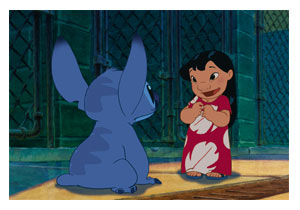 |
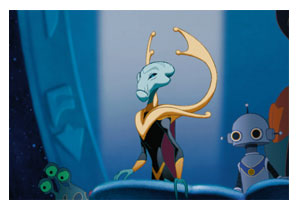 |
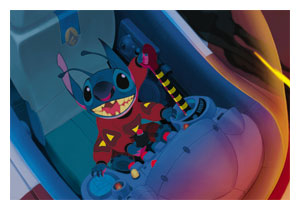 |
From a June 2002 interview by the Internet Movie DataBase:
Q: We don't have much trivia for Lilo. Give me some:
DeBlois: This is the first film, maybe ever, in the Disney history where the film was written, storyboarded, and directed by the same two people. Usually, there are about twenty people doing that job. We had promised the studio that we would make a movie that cost less, with a smaller crew and would take less time to make it if, in return, they let us take a few story risks. That meant we could venture down a path that wasn't about an angst-ridden teenager that was looking to prove him or herself. This is a redemption story. This movie starts where most of our films end: "THE VILLAIN HAS BEEN CAPTURED."
Q: What got taken out though? You had to compromise on something...
DeBlois: Oh, absolutely. We had early screenings and certain things that we thought were funny others found completely over the top. For example, when Jumba the creator comes into the house to try to catch Stitch, that used to be far more over the top. They were playing with gas mains and throwing ovens at each other; the scale of the damage was huge. We thought it was funny. But as it turned out, from the cards and the feedback we got back, the kids were stressed out during that sequence. They'd seen enough of Stitch's vulnerabilities and come to like him so much that they were really worried about him during that battle.
Q: Well that was pretty good trivia...
DeBlois: ...oh yeah, and our second act, it used to be really dark. The little fish that Lilo talks about when we first meet her? The one she feeds peanut-butter to? She takes Stitch to meet him and, in the process of being really irresponsible, Stitch tosses the fish out the water and it gets attacked by a flock of seagulls and is killed. And it's kind of a lesson he has to learn, that his actions have consequences. He follows her to the graveyard where she buries this little fish right beside the headstones of Lilo's parents. It was to show that there's a real impact to your actions and that family is about protection, not carelessness.
Q: It must have been effective.
DeBlois: It was very effective. People got the point and they really felt bad for Stitch, but it darkened our second act so much that you couldn't come back out of it.
Q: How far along was that?
DeBlois: I think it was mostly in storyboard, although a few scenes had been animated.
Q: We talked with Jeffrey Katzenberg about Spirit: Stallion of the Cimarron and asked him if there was a "Black Tuesday" on the film (Black Tuesday was so named by the Disney animation department for the day when Aladdin got drastically overhauled) and he replied, "There's always a Black Tuesday on these films."
DeBlois: What's funny about that is we were fully anticipating our "Black Tuesday"; it's the way it always works. There's a massive meltdown that happens but on this film it didn't happen. The only thing that came close for us to a meltdown, though it didn't shut the production down, so it doesn't really qualify, was when it was decided that Stitch would no longer be a gang leader with an intergalactic gang at large that would come back at the end of the film to rescue him.
Q: Come again?
DeBlois: Stitch was actually on trial, at the beginning of the film, as an adult. He and his gang had been riding around as hooligans; they were basically the 'Hell's Angels" of space and Stitch gets marooned during his escape on Earth. The whole second act was about him having to deal with Lilo, putting on the act of being a dog, contacting his gang and avoiding capture from the bounty hunters. Another interesting point is that Jumba, who is now his creator in the finished film, used to be an old gang member who had been stewing in prison because they'd left him behind in a bank heist. In the original story the gang finally arrives and notices that their leader is really protective of this Earth creature, he seems different, they're wondering if it's a set-up and right then the Galactic Police arrive and they think they've been betrayed. It was complicated to explain and that gang was only in the film to showcase just how much Stitch had changed. But we decided that, even though some of these sequences are already being animated and most of the gang characters designed and animated, that we had to stop and quickly repair. We decided to put the problem within him. He's a genetic creation. It's not a conscious choice that he destroys these things; he was programmed for it.
So, the old gang member stewing in prison becomes a creator. We slapped a lab coat on him and-presto!-Dr. Frankenstein. And that was also the point where we gave Stitch the "Ugly Duckling" book.
Q: It all seemed so very organic when watching it...
DeBlois: I have one other little bit of trivia, if you want it.
Q: Absolutely.
DeBlois: That Agent Cobra Bubbles [voiced by Ving Rhames] was a former CIA person who had dealt with aliens? That was a last-minute, goofball decision we threw in in editorial. We thought it kind of silly that this grown adult, who is very serious, takes no notice of the aliens on the beach, but we can't have this protracted scene where he's trying to make sense of it because it's the end of the movie. So we put in these lines where he'd interacted with them before. "Oh, yes, you used to have hair then." And now, people who watch the film say, "I knew it! I knew he was there to investigate aliens from the beginning" and we think to ourselves, "No, he's not, but if it works for you, great!" We just thought it funny that this social worker was an action movie cliché
Q: He's like Mr. Wolf, coming in to clean up in Pulp Fiction.
DeBlois: It's funny you should say that because when we're casting these films we often will pull a performance from the actor we have in mind and cut it together with still drawings, just to see if they feel right. The only thing that we had of Ving Rhames, in character, for who we wanted, was the stuff from Pulp Fiction. So we cut some of these lines and every one of them was so profane...
Q: "That's pride $%#*@&#^ with you."
DeBlois: (laughing)...and we had to present that to the Disney
executives and say "This is our idea. We want Ving Rhames for Cobra Bubbles."
CHRIS SANDER & CLARK SPENCER INTERVIEW
The Washington Post held a Q&A session with director/writer Chris Sanders and producer Clark Spencer on May 1, 2002. Below is the transcript:
Q: It seems as though Stitch will soon be known as the bad-ass of Disney annimation. Seeing as Disney usually goes the "lovable character" route, I was wondering if you had any trouble convincing the powers at Disney to buy into the idea of Stitch.
Chris: This is a character that does defy Disney conventions and everybody, including the president of animation was so behind the film. We all saw it as a step in a new direction. Tom Shumacker in particular kept it a secret for a while so we were fully able to work out the quirks before we rolled it out and show a lot a people.
Clark: I think Tom was very smart in how he approached the project in terms of protecting it in its incubation period, so by the time it rolled out, the entire idea was very gettable -- and people would understand that it's unconventional, but very reminiscent of the films of the 1930s and 40s.
Q: Chris -- you directed/wrote AND voiced Stitch? That's a lot of work. How did you handle the varied responsibilities? And how long did this movie take to make?
Chris: I actually didn't do it entirely alone. In animation you have a co-director who helped me out. Dean and I both came from the story dept at Disney and we made a deal with our crew (320 people) -- we promised we would write in the story board a very unusual, solid movie if they would take on the responsibility of doing their own approvals in their own departments. So we were absent from meetings we would normally be at. We had to let go of some of the responsibilyt. The Florida studio is a very talented studio. When you're in development, it's about two years to the actual movie. Stitch's voice is a voice I always used to amuse my friends and Stitch doesn't really speak English, so rather than hire a prestigious actor to grunt and squeak, we thought I could do it. The less dialogue he spoke the more effective it was.
Clark: The only thing I would say is that Chris and Dean being the screenwriters and storyboarding is that you get this vision so focused and not having other people coming in the path. They know exactly what they want to see on the screen. As Chris said, you have to have a lot of faith in the people who head up the rest of those departments. We were very fortunate in that. Everyone took on part of the directors burden. It made the process really easier.
Q: How do you feel about the creation of the Academy Award for Best Animated Feature Film?
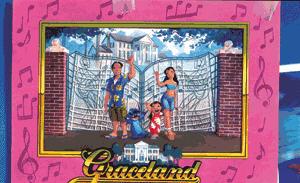 Chris:
I'm really excited because as everybody knows, these are as legitimate
as every other film and take as much talent, yet it's always difficult
to compete with a live action film -- because they are very different while
just as legitimate. So it's a very welcome one.
Chris:
I'm really excited because as everybody knows, these are as legitimate
as every other film and take as much talent, yet it's always difficult
to compete with a live action film -- because they are very different while
just as legitimate. So it's a very welcome one.
Clark: I would concur with Chris. Fantastic.
Q: What age groups are you hoping to reach? Might Stich appear, at least in the advertising on the Web site, too frightening for young children?
Clark: I think we hope that we are going after everybody. Obviously there's a core Disney following. In some ways, we're writing them for ourselves. Part of the ad campaign is getting this different character out there so people get a sense of who he is before the film. We hope people see him as exciting and mischeiveious, but also cute and funny. People seem to be very intrigued by him.
Chris: I can't imagine anybody not liking him. I think his edge is something exciting. He has as much sweetness to balance out the edge. There's a deep emotional core that's probably going to surprise a lot of people.
Q: I really like the interactive games that Disney puts out on sites for the movies. Did you have any role in planning or programming on the Web sites?
Clark: It's a little bit of both. A Web group and us. They met with us early on. That we'd start by revealing a bit at a time, then revealing Lilo. But specifically, the games are done by another department. We're very fortunate in that. I think because Stitch is so interesting and Lilo is wonderful, there are so many things to play on -- space and Hawaii.
Q: Will characters from other Disney classics appear in the movie or is that just part of the movie trailers?
Chris: That's just the trailers. It occurred to us that Stitch really doesn't fit in with the traditional Disney characters -- so that's why we did that and always have a piece of the real film on these little trailers.
Q: I had a question about the process of making Lilo and Stitch. As you initially came up with the idea 17 years ago, I was wondering how much of that original idea was part of the final product? Was there anything pertaining to the movie either of you wished you could have accomplished, but had to sacrifice?
Chris: The character of Stitch is largely unchanged. His design was updated and his situation was largely changed, but the character retained all the things I thought of from the beginning. A frightening character with an inner innocence that would develop throughout the story. And that's one of the most exciting aspects of the movie. We have a lot of stuff that didn't get in the movie. We have many different scenes that had to be removed because of time constraints. There was one with LIlo reading to Stitch about mummies at the breakfast table -- one of her fondest dreams. She pointed to out to Stitch that Eva Peron was one of the greatest mummifications of all time and that had to be cut out. In a lot of cases, characters have a history that you're never going to see. And Lilo and Stitch are no exception.
Clark: The process takes so long, we're already in production for a sequel and TV series. We'd like to take some ideas that couldn't be used in the film.
Q: What should someone study in order to break into the film animation business? How does one get an entry level position?
Chris: There's a lot of different types of animation now, so it's wonderful in that you can approach it in different ways. Drawing by hand are still valid ways. Even if you choose to go into the computer aided side, the space you deal with on a computer screen is no different than those on paper. In all cases you eventually are going to bring a portfolio to a studio somewhere, so you need to become skilled. You can find out what each studio is looking for by giving them a call.
Q: Did you have any trouble getting permission to use the Elvis songs in the movie?
Clark: We were really fortunate. The idea of Elvis coming in to the movie raised concerns. But when the idea was pitched to the record companies and Graceland estate, they immediately embraced the idea -- because it reaches out to a whole new generation of fans. We had an opportunity to show the film to Graceland about four months ago. And they were thrilled.
Q: What was is like working for Disney? Is there a "Disney formula" you had to work within? How much creativity does Disney provide you?
Chris: The great thing about working for Disney as an artist is that the sky is the limit as far as what you want to bring to the party. We wanted to break with convention and formula wherever we could. The studio completely welcomed that. I think we'll see more of that in the future as we search for different kinds of stories to tell.
Q: What are your opinions on Disney's recent trend of issuing straight-to-video sequels produced by off-shore (and in my opinion, sub-par) animators?
Chris: The sequels are always well received and it seems to be
something people enjoy seeing, but at the same time we're not going to
continue to re-release sequels. So, don't be worried, because Disney will
always be breaking new ground.
Q: Is it just me, or is Stitch reminiscent of a Gremlin?
Chris: There are lots of qualities to Stitch. I think they're referring to the movie Gremlins. Not deliberately, but he does share characteristics. I think he shares most of his heritage with bats. I think there couldn't be a more alien species on the planet. I also got rid of the idea of having pupils... he has these glossy black eyes that are actually really expressive. I think sometimes giving an odd character black eyes allows you to read emotions into that character more easily.
Chris: I'm super thrilled that everybody has seen this film to be different, because it is. It is a very bold step and very emotionally charged film. Everyone should see it if they have an interest. They'll have a thoroughly fanstastic time.
Clark: I think Chris is right in terms of the film being completely
different, but that emotionall charged component is somethign we see as
a surprise, but it is still reminiscent of Bambi
and Dumbo. So, it is very similar to what
Walt and his team did back then. So we hope to give people something they
expect and something they don't expect -- both at the same time.
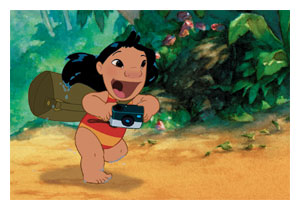 |
 |
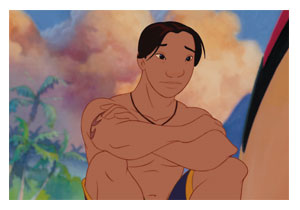 |
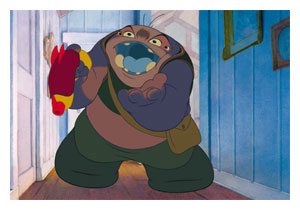 |
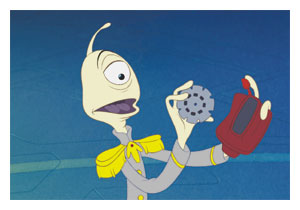 |
David Manning from CHUD.COM sat down with Lilo & Stitch's producer in May 2002, for what turned out to be a fantastic interview!
Q: The first thing that struck me about this film was that Disney doesn't really have any music in the film: it's all Elvis. How did you handle the rights issues?
Clark Spencer: You know, when (Director Chris Sanders) pitched this concept for the movie, he used Elvis as a characteristic to describe Lilo. We never meant to have Elvis music in the film. He just said "Lilo's this little girl. She's lonely. She carries around a vinyl record player and she listens to Elvis music." But as the film started to evolve, we really gravitated towards that idea of Elvis and said "wouldn't it be fun to put some music in?"
So first, of course, you have to go though the legal department within
Disney and contact the people who own the rights and talk to the Graceland
estate, and there was some trepidation in terms of "would we really be
able to pull this off?" But I have to tell you, everyone we approached
was so intrigued by the idea that we were going to put Elvis music in a
Disney animated film... that it would take this music to a whole new generation
of kids, that there were no barriers - truly - no barriers.

When we pitched the film, we talked conceptually about what we wanted
to do and showed that the idea was to portray Elvis in this great light
and not in a negative light, everybody just lined right up and said "OK,
tell us what you need and what you want, and we'll be there for you." In
fact, there's one sequence in the film where Lilo teaches Stitch how to
be a model citizen, and she uses Elvis as that example.
We had to do things that you're just never allowed to do without a ton of permission: Show an Elvis picture and mention his name, put Stitch into the white jumpsuit from the Hawaii concert, and actually take "Devil in Disguise" and mix it around - the guitar solo comes in the song after the second verse, but we needed it to come after the first verse, so we moved things around - no problems whatsoever.
So we were very fortunate. No doubt, going in, we thought "would this really be able to work?" but once we got in there and started to talk to people, everyone was very excited.
Q: So, did you license it...
Clark Spencer: Yeah, for the film, we did. We licensed those songs. There are six Elvis songs in the movie that we licensed for the film, and we went off and did two covers.... Five of those six (Elvis) songs are going to be on the soundtrack, so they gave us the rights to put those songs on to the soundtrack. Obviously, everybody gets their piece... But it's...
Q: Profit sharing agreement?
Clark Spencer: Absolutely, which is very exciting, really. As far as we know, nobody has ever been able to get that many masters on to an album that wasn't RCA ... you know, RCA owns most of the masters, so to have it not to be on a RCA label is a pretty big step.
(Note: According to published reports, Lilo & Stitch had to undergo a heavy edit following the 9/11 attacks. Reportedly, the film's final chase scene involved Stitch stealing a 747 from the Honolulu airport, and flying it through the city itself, dodging things like skyscrapers, buildings & such.)
Q: I understand there were a lot of changes made after the September 11th attacks, and that a sequence had to be significantly altered as a result. How did you approach that problem, and how did it affect the bottom line of the picture?
Clark Spencer: You know, September 11th happened. We were on east coast time, and within a couple of hours, we realized we had to make a change in the film. There was no meeting - It wasn't even a conversation in some ways - it was just sort of obvious, out of respect, that this part of the film needed to change, but we still needed a rescue. And so, the directors and myself went into a room and tried to figure out how we were going to make this change and be very smart about it, because we're at the very end of our production process.
I'm very fortunate to work with people like Chris and Dean (DeBlois, Co-Director). They come from story, and they can surgically go in and come up with a way of doing it, which doesn't mean you have to alter everything significantly.
Basically, we went in and took what was an airplane and transformed it into a spaceship. We were able to keep much of the same animation and much of the same moves that had already been choreographed and planned for that sequence and just kinda trade the two out. We were lucky because we had never talked about how Jumba and Pleakley arrived on earth, so they could go back to the spaceship that was just hiding in the woods, and the rest of it could just happen from there.
What's amazing is that... When you have a moment in time at the end of a film, everyone's really ramped up, and they're able to push stuff through very, very quickly... And when you have everybody knowing that this is the right thing to do, out of respect for that moment in time, people just work their butts off. And, to be honest with you, our schedule change, which should have taken us several months to do, probably took us about 3 and a half weeks. We were fortunate, because we had already planned our film so that it was going to get done early no matter what for the summer release. So, we had the luxury of time to finish it.
Q: Was the Airplane footage ever put together? Do you think we'll ever see it on a DVD someday, maybe as a special feature or some such?
Clark Spencer: There may be. We're starting to talk about that kind of stuff right now, it terms of what types of scenes from the film that were originally done will now be seen on the DVD... there's actually several in the film that changed as we were making the movie. It's a natural part of our process. Because it takes so long to make them, we put 'em up, and we decide what's working and what's not. So, there'll probably be several things on the DVD. (Note: They'd better work fast. According to film site DVDToons.com, Wal-Mart is expecting to have the Lilo & Stitch DVD on its shelves by December 10th of this year.)
Q: I understand there are already a sequel in development over at Disney's TV animation division, along with a Children's television show. Are you involved in those projects?
Clark Spencer: Yeah, we are, a little bit. It's interesting. In our process, it takes so long to do these things, so you've got to commit early. Even before the film comes out, we've already started development for a sequel for the TV animation division to actually animate, as well as a TV series. Our involvement has been more in the setup -- what these two films will be about storywise. There's a whole different team of people that'll actually go off and direct and make them. We wont be involved in that part of the process. But in terms of the initial ideas, and what's going to happen to those characters, we've been intimately involved with that part.
It's kind of fun, but it's weird at the same moment. Your film hasn't even been released, and people are already talking about how it's going to have this longevity. It's the first time for us that we've stepped back and realized that the movie may actually have a life of its own. You don't assume that. You just assume that you're making your movie, and it'll come out, and then one day it'll be gone and nobody will ever talk about it again. But you forget that we're part of this very large company, with the Disney name on it, that will go out and use these properties in many different ways.
Q: On that note, have you been approached about the possibility of a Lilo & Stitch-based attraction for the theme parks?
Clark Spencer: Yeah, we've talked about several different ideas, none of which have been definitely committed to. On some ways, I think we'll wait and see what happens from the standpoint of the film opening. But there are several really fun ideas - one for Walt Disney World and one for Disneyland - for using Stitch, 'cause he's this great kinda character that you can really throw into some different attractions in different ways. Most likely, they would go in and re-theme some ideas that already exist, rather than create a whole new attraction around Stitch. There are a couple of ideas that I really hope come to fruition. It's an interesting part of the company, to sit around and brainstorm with. It's a great group of people - they're so talented, and good at what they do.
Q: Disney recently shuttered its California animation facility in
Burbank. You're acutely aware of the costs associated with making high-quality
2-D feature films. Is this the beginning of the end for 2-D animation at
Disney with the advent of outsourcing, or is there something else going
on?

Clark Spencer: I think it's interesting. A lot of people have
been focused on this idea of 2-D animation being replaced by 3-D. In our
business, it takes so long to make these films, you don't look at it that
way. When this film was pitched, no one had any idea that Shrek,
Monsters
Inc & Ice Age would all hit
at the same time, so... It's interesting. We're kind of at this exciting
moment in time, to see what's going to happen with this movie, yet nobody
planned it this way.
Disney is still committed to 2-D animation, if you look at the fact that Treasure Planet (Fetal Page), a film called Home on the Range, and a film called Bears, which is being made at the Florida Studios are all 2-D films. I mean, we're still very committed to that medium. Obviously, from a business standpoint, we're looking at how big we've gotten. And at one point, I think we grew in a huge way, and we were making many films. Now we're pairing back a bit. I think the focus has been "are we getting out of the 2-D business?" and it's not about that. It's about realigning the size of your crew to have it be about the right size for the number of films you should be making.
Q: What's Next for You?
Clark Spencer: Well, my career's interesting, because I wasn't supposed to be a producer -- I was in finance. My career had taken off, and that's what I was doing when they asked if I'd take off and run the animation studio in Florida, and I said "Yes! I'd love to go do that." While I was down there, they asked me if I'd wanted to produce this film. As we got to the end of producing it, I started to think to myself.. "is producing what I want to do, or would I choose to go back to the General management or finance path?"
It's really energizing being a producer because you get the best of both worlds. You're doing what I think I've been trained to do my whole life, which is general management, globally oversee a project, manage people and getting it done, but you're really close to these people who are incredibly talented and creative. And the ability to kind of see that talent on a daily basis is just completely energizing.
I knew when I started with entertainment that my strength was in the business side, but I really wanted to be close to the creative and talent side. So I think this is kinda the best you could get, in some sense. So, I'm going to actually work with Chris and Dean again and do another animated project.
Q: Can you tell me anything about it?
Clark Spencer: We're actually just starting to develop it. We've been so busy with this film that we've just started to talk about ideas. I think once the film gets released in June, we can really focus, and hopefully within a few months, we can pitch an idea to the company.
Q: This is a very different film for Disney. How on earth did it ever get made?
Clark Spencer: You know, I think everybody wants to believe that we must have had to fight and fight and fight... it's interesting... Chris Sanders, one of the Co-Directors.. he's a veteran of feature animation, been here since 1988, I think. He's worked on Rescuers Down Under, The Lion King, Beauty and the Beast... He's SO talented, and Tom Schumacher, who heads up feature animation, has a lot of faith in him.
Chris had said a long time ago to Tom, "I want to make a movie that's completely unconventional."
Tom said "Great! Go away and think about that idea and come pitch it to me."
Chris came back and he pitched this idea of Lilo & Stitch to Tom. And Tom was really intrigued by it, and said, "OK, great. I'm going to now give you a little bit of a leash. Go away, and spend some time, and come back and have a more fleshed out treatment." So Chris went away and he did kind of this illustrated storybook format, with little illustrations in it and the theatric storyline.
Tom continued to be really intrigued by the idea, so he said, "Great! Now what we're going to do is set you up with a team of people and you're going to go off in sort of a stealth way and continue to develop it." So, instead of immediately saying "This is this great idea! I'm going to tell everyone in the company!" Tom was really smart. He could tell there was a germ of something fantastic here. He didn't want to let it out too early - so he protected it.
There was a long incubation period where the project stayed with a very small group of people, being worked on... being developed...before it started to roll out in a bigger fashion. Making the film in Orlando, Florida helped. It got it out of the Burbank area and into this isolated zone where we could continue to make it.
Tom was really clever. He protected it until that moment in time where he felt like he could show it to people and they'd get it. Because the idea was so unconventional that there was that risk that people would put up a flag and say "What!, you can't make this film! It doesn't feel like the films we have traditionally made." But he KNEW there was something in it that, at its heart, was reflective of the films of the 30's and 40's. They were gutsy. Films like BAMBI & DUMBO are not obvious stories. They have these great emotional sides to them, and they have these darker sides to them and they have comedy in them. But there's a lot of depth in them. And Tom, I think, could see that. So he was very smart in terms of protecting it.
So we were pretty fortunate. By the time we actually had to, if you will, expose ourselves to everybody and share the film, it was at a point where we had a lot of confidence in what it was. People immediately gravitated towards the idea that it was so different, yet it had some of these things that were reminiscent of earlier films.
Q: Another thing I've noticed is the marketing of the film - it's tone is almost Anti-Disney. I'm curious how the culture of your team interacted with the other people in the organization who actually made those wonderful films you're skewering. Was there any friction? How was it handled or soothed, or dealt with?
Clark Spencer: It's funny, because we started talking in October about the fact that Lilo & Stitch is a tough movie to market: The idea is not immediately gettable, the title's not something your familiar with, and the story is not something your familiar with at all. So, how do you get it out there? We talked to the marketing department, and they came up with the idea that we needed a "pre-awareness campaign" as we started to call it.
So the directors went off and said, "wouldn't it be funny... since Stitch is going to become a part of the other characters and part of the (Disney) legacy, if we actually had Stitch invade these films like he invades the family in the movie?"
So they came up with the first one, which was Stitch being presented at that moment in LION KING where it's supposed to be baby Simba and it ends up being Stitch. And we were kinda cracking ourselves up, in some sense... We thought it was such a great idea... but we knew there'd be a lot of hurdles to get over. It was such an "out there" idea, and it clearly was going to step on many toes.
Again, and I hate to make it sound all so positive, but its true: as we started to show it to people, I think the idea was so solid -- people got it so quickly and thought it was so unique -- that everyone basically let their guard down, and said "We have to do it." It was sort of one-by-one, 'cause first we pitched it to the marketing department, and we thought "well, maybe they would say 'you can't do that'" and they said "Fine." And then we pitched it to some of the executives. And we thought they might say "No." and they said "Fine." And then we pitched it to the Legal department, to see what issues they would have, and they said "OK." And we finally went to the top of the company, to Roy (Disney) and Michael Eisner and said, "Here's what we want to do. How do you guys feel about it." And again, they loved it.
Stitch is a unique character. I don't think there are a lot characters you could do this kind of a campaign with. But it just worked. All the timing lined up right. And there's no doubt we have a film that you needed to have a smart, clever, unique campaign to help launch it. It's a competitive summer, and you have to have something that's going to make kids say early on "that's movie I want to see" and I don't think in today's world you can just rely just on having a trailer or two out there in the marketplace to get people excited about your movie. You have to have something else that kind of lures them in early on, so they're out there talking about it and getting a buzz going. It's the only way to survive, in some ways.
Q: I know that you began your career in management & finance at Disney, and this is your first gig as a producer. How has this experience changed the way you look at this end of the business?
Clark Spencer: One of the things I learned - I was in finance within feature animation, so I spent a long time looking at budgets trying to figure out why it took time and money to do certain parts of our process. What you realize is that you can't tell someone to be creative today. When you work so closely with Chris and Dean, who are the writers on this film, you want to go in and say "OK, we have one day. We need to figure the problem with this part of the story, We need to storyboard it tomorrow and we need to have an animation on Wednesday." But it doesn't work that way. You wont get your best ideas. You have to be willing to relax, in some ways.. but you have to push - because you can't sit there and not have the pressure there.
But you have to realize that there are going to be certain days where as much as you -- from an analytical, financial standpoint -- just feel like you have to solve this problem today, nobody's brain capacity or brain space at that moment in time is ready to do it. The best ideas are not coming. You have to just breathe and say "Maybe tomorrow we'll hit the answer to our problem. Maybe the next day." Each of which is costing you money, but you know in the end, the idea will be better. Therefore, it will work out financially in the long run. But that day, you're sitting there sweating it out, thinking "God, if we could only figure it out."
So I think my approach to business would be, in some ways, that you have to push, and you have to have that pressure... but you also have to relax, and understand that not everything is going to be in your perfect world. You can't always plan for everything.
Q: I know they crashed your release date, that you were set for a
release next summer.
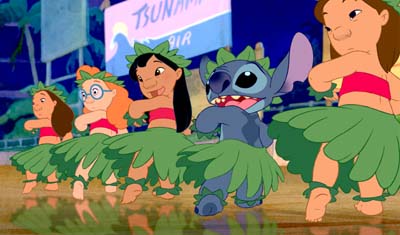
Clark Spencer: Actually, that's' not true. It got out on the
Internet that we were going to be 2003. But we were always going to be...
well, we were going to be spring 2002, kinda in the Ice
Age time period, and then probably around 18 months ago they got
excited about the fact that this film was taking place in Hawaii, and said
"you know what, it'd be a great summer film. Lets put it in the summer!"
So, Treasure Planet kinda moved
their release date, and we moved into the summer. I don't know where that
came from. I wish we were so good we could finish a movie a year in advance.
Q: This is the first Disney film since Dumbo to be done in watercolor. You had to spend a lot of time and money retraining artists in a new medium. Did the decision meet with much resistance?
Clark Spencer: You know, we were lucky. When Chris did his first pitch book, those illustrations he used were done in watercolor. Tom (Schumacher), the head of feature animation was really attracted to the look of it, and he said "I want to make this movie in terms of the story, but I want it to look like this." Now, that didn't mean we were going to do watercolor - that just meant that he wanted THAT look. So we went off and explored -- could you take acrylic, or gloss paint, and have it look like watercolor? And it didn't seem to look that good. So, we decided to go out and attempt to train the artists.
What we all agreed to was sort of a test period, where we would go out and see if it was really working. Again, it takes over two years to actually make the film from a production standpoint, so we knew we had a little bit of time - If we got into it, and it wasn't working, we could change gears.
Fortunately, people were so committed to trying to make it work that people put their heart and soul into it. So many people were saying "I don't know if you can actually pull it off," they were like, "we're gonna pull it off. We're gonna completely prove that we can do this." The Orlando studio has that kind of fighting spirit. It's a young and new studio, and they were really adamant they were going to pull this off. In the end, we actually painted the paintings faster, from a production standpoint, than acrylic and gloss. Nobody would have guessed that you could do that. But these people just became Ninja Painters, and were completely cranking this stuff out in just a phenomenal way.
As a producer, when we first went into it, and working with my associate producer on planning out the schedule, there was a little bit of you know, keep our fingers crossed, hope we can do this. But I feel firmly that you have to let people go off and try it. You can't say "No" because you think it may be risky. You have to be willing to say, "lets try it, we'll give it a fair shot." If it doesn't work, we'll switch gears. So we sat back and let everybody else creatively drive it, and it ended up working out.
Q: You're talking about the special people at the Orlando Studios. There's been a lot of discussion about Disney's increased reliance on outsourced animation. Could you have made this movie with outsourced animators?
Clark Spencer: I don't think so. Where we outsource tends to be more in the TV animation division. There's really nothing from the feature animation standpoint that we outsource. And I think that's what make our films have that Disney look, and a very high quality. I mean, we really nitpick these things to death. We have such talented artists, that I think that outsourcing would be complicated.
One of the things I don't know if everyone realizes from the standpoint of what directors do in an animated film is that they spend all of their day approving stuff. Every half hour is booked in a meeting, and they look at stuff -- frame-by-frame. Whether it be rough animation or cleaned up animation or painted characters or a background or a layout, you're evaluating it. It's really going in and Noodling and nitpicking everything.
It doesn't mean that there's not talent out there in the rest of the world, 'cause there is. It's just hard if you're going to send a scene over through FedEx or something and say "Here's the basic emotion. Please animate it", and not be there day-in-day-out to look at it. You could try and figure out a movie, put it in a box and ship it out somewhere else. But you'll never get what you get by having the ability to have everybody so intimately involved with it. It'd be really hard. Again, there's talent everywhere, but it's the ability to be right on site, managing it in such a close and careful and clinical way.
Q: Disney is farming off more and more of its first-run feature work to the TV animation division and, vis-à-vis, to outsourced animators. What is this going to do the Disney brand?
Clark Spencer: You know, it's definitely a wrestling thing, and we are always trying to figure out how to keep quality at a certain level. Ultimately, I think people want to see family film. We in feature animation cannot make any more product than we are currently making. It's such a big, laborious process. Plus, it's an expensive process, so you really only have a few windows during the year that you can release it and know that you might have a market large enough to recoup your investment. From a TV animation standpoint, you have a different cost structure, so you have many other windows of opportunity that stuff can get done out there, plus you have infinite resources, 'cause your using other sources to make that animation.
Ultimately, it's about having people realize that there are going to
be different quality levels. And really, its only the people who really
know animation that notice those aspects of it. Most people go because
they want to take their kids and see good fun. You go see what people see
what people saw when they saw Return
to Never Land, and it's people that follow animation that really
come back and say "Wow, I noticed these things about it." If it's a good
story, how the medium's made shouldn't have that much of an impact... if
it's a good story.
 |
 |
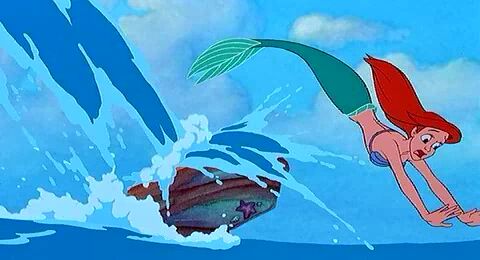 |
 |
From the 12/2001 issue of Prevue Magazine.
Q: You are providing a voice for Disney's Lilo & Stitch, what can you tell us about it?
It's so cute! It's set in Hawaii and I play the guardian of my little sister. I've been working on it for two years. It's a much heavier film than you have ever seen from Disney, in that the girl's parents aren't present. You just sort of infer that it's the older sister taking care of the younger sister. I'm working hard, trying to get jobs, and there is a social services worker checking on the welfare of the child. I'm constantly trying to keep my head above water, so that Social Services doesn't take my sister away!
Q: Social Services? That's a bit different than your average Disney film.
It's very modern, and it's also very charming, and very poignant.
Q: So how does it feel to be a Disney character?
It's great! I've always wanted to be a Disney cartoon character. I was really upset when Mulan when slipped through there.
Q: Did you hope to get that?
I had heard about Mulan and thought it would be great. It has the same casting director as Lilo & Stitch and apparently she tried to get in touch with me, but I was in Slovakia shooting a film. When I walked in for the first session of Lilo & Stitch, she told me that she had tried to get in touch with me for Mulan. In the end, it all came around for a great project. Anyway, I'm more from Hawaii than I am for Mainland China. Besides, I get to sing in it too! I get to sing a Hawaiian song to my little sister.
Q: What do you sing?
I get to sing Aloha O`e, which is a traditional Hawaiian song that was written by Queen Liliuokalani, the last Hawaiian monarch.
Q: With all your travels, where are you recording Lilo & Stitch?
While I'm working on Relic Hunter, they'll pop in and say, "we've just got to get a line, or two." I was working out at rock quarry, an hour-and-a-half outside Toronto and there was huge machinery passing by. Now, my trailer's wonderful, but it's not exactly soundproof. We had this whole recording set-up in the trailer and we were waiting for the rock quarry trucks to pass, so we can get one clean line.
Q: They actually use that line and it's not redubbed later?
No, no, they are amazing. They piece it all together. Jason Scott Lee was in London, so the directors and producers flew to London to record him there. When I was in Paris, they needed a line, so they could show the animation to their hire-ups at Disney, so I was in Paris, so they had to come to Paris.
 Q:
Do they use your physical movements at all?
Q:
Do they use your physical movements at all?
Although the character girl doesn't look like me, they videotape me as I am speaking, so they can see how my face moves, how my mouth moves.
Q: How is working for Disney?
It's a wonderful atmosphere, very relaxed. They crack a joke, I crack a joke.
Q: Have you had any input into your character?.
I really get to inject a lot into it. I've felt very free to inject
some Hawaiianisms into the film. In Hawaii, there is a dialect we speak
called Pidgin. It's a bit like broken English, but it's not that you are
saying different words, it's just the way that you say them. It has a different
intonation. I asked them if they wanted Pidgin, since this was supposed
to be Hawaiian, and they said "sure, as long as we can understand it."
So, I started improvising some dialog. I gave them some local Hawaiianisms
that would still hold up to the general public, but that local Hawaiians
would get a chuckle because it is so "on the money" for local people.
|
||||||||||||